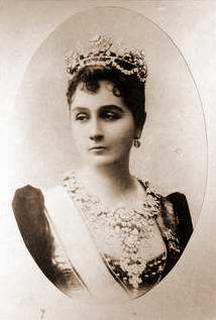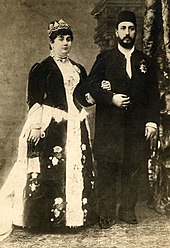Emina Ilhamy
| Emina Ilhamy امینه الهامی | |
|---|---|
 Nineteenth century photograph | |
| Khediva consort of Egypt | |
| Tenure | 25 June 1879 – 7 January 1892 |
| Predecessor | Title created |
| Successor | Ikbal Hanim |
| Walida Pasha of Egypt | |
| Tenure | 8 January 1892 – 19 December 1914 |
| Predecessor | Shafaq Nur Hanim |
| Successor | Nur Felek Qadin |
| Born | 24 May 1858 Istanbul, Ottoman Empire |
| Died | 19 June 1931 (aged 73) Bebek, Bosphorus, Istanbul, Turkey |
| Burial | |
| Spouse | Tewfik Pasha |
| Issue | Abbas Hilmi II Pasha Mohammed Ali Tewfik Princess Nazli Hanim Princess Fakhr un-nisa Khadija Hanim Princess Nimatullah Hanim |
| House | House of Muhammad Ali |
| Father | Prince Ibrahim Ilhamy |
| Mother | Parlanta Qadin |
| Religion | Sunni Islam |
Emina Ilhamy (Template:Lang-ar; Template:Lang-tr; 24 May 1858 – 19 June 1931),[citation needed] also Amina Ilhami, was an Egyptian princess, and a member of the Muhammad Ali Dynasty. She was the first Khediva of Egypt from 1879 to 1892 as the wife of Khedive Tewfik Pasha, and Walida Pasha to their son Khedive Abbas Hilmi II Pasha from 1892 to 1914.
Early life
Princess Emina Ilhamy was born on 24 May 1858 in Istanbul.[1] She was the eldest daughter of Lieutenant General Prince Ibrahim Ilhamy Pasha,[2] and his consort Parlanta Qadin (died 1892).[3][4] She had one sister named Princess Zaynab Hanim, who married Mahmud Hamdi Pasha, fifth son of Isma'il Pasha[5] and Jihan Shah Qadin.[3] She was the granddaughter of Abbas Hilmi I, and Mahvish Hanim.[citation needed]
Marriage


Princess Emina married her father's cousin Tewfik Pasha on Thursday 16 January 1873. In celebration of the event Khedive Isma'il held a reception at al-Hilmiyya Palace attended by Tewfik, several ministers of state, and the leading religious dignitaries. Cannon were fired, sweet drink were had, and the khedive received the congratulations of hus guests in order of their rank. Poetry was composed and recited for the occasion by al-Sayyid Ali Abu al-Nasr and Muhammad Qadri Bey. These events initiated a week of receptions, banquets, and entertainment, illuminations, and a public procession in which the bride was delivered to the palace of her husband.[6]
The two together had five children, two sons, Prince Abbas Hilmi Pasha, born in 1874 and Prince Mohammed Ali Tewfik Pasha, born in 1875, and three daughters, Princess Nazli Hanim, born in 1877, Princess Fakhr un-nisa Khadija Hanim, born in 1880, and Princess Nimatullah Hanim, born in 1882.[7][1]
After Tewfik's accession to the throne in 1879, Emina took a more prominent public role than women in the khedival family had done previously, partly as a consequence of being his sole consort. She was respectfully referred to in the Arabic press as "the wife of khedive" (haram al-khidiwi), and in French and English as the vice-reine, khédiveh, or "khediva."[6][8] With the death of Tewfik's mother and paternal grandmother in 1884 and 1886, she became the senior woman in the khedival household.[9]
As khediva, she regularly received the wives and daughters of European diplomats and visitors. Her presence at official events was mentioned regularly — attending the opera, moving from one place to another — also were published. When present at state events, Emina and her entourage would sit behind a screen, and on holidays she would receive the greetings of female guests personally, while those of the male guests were conveyed to her by her chief eunuch. The press usually discreetly avoided mentioning her name.[9]
As Walida Pasha

At the death of her husband Khedive Tewfik of Egypt, her son, Abbas Hilmi Pasha, whilst still attending college in Vienna, assumed the throne with the help of his mother on 7 January 1892. As a result, Emina retained a prominent role as the walida pasha, or mother of the khedive, though English writers often used the French term khédiveh mére.[10] She maintained the seniority as the Walida Pasha, which she had when she was a khediva, and continued to have a diplomatic role.[9]
Princess Emina was as beautiful as she was kind and dignified, and a much revered member of the royal family. In possession of a large personal fortune, Princess Emina gave a great part of it away in donations and charitable institutions, and was surnamed "Umm al-Muhsinin" (Mother of Charity).[11] A girls' school that she founded, whose principal ornament is a heavy, ornate sabil in Turkish baroque style, stands close to the mosque of Ibn Tulun. It is now known by the name of Umm Abbas, 'Mother of Abbas.'[12]
Emina and her son Abbas seem not to have found slavery objectionable in principle, since they kept slaves in their households until the First World War. Even though her husband, Tawfiq, professed opposition to slavery, Amina presided over a harem of slave women, three of whom she gave to Abbas. In spite of breaking with some aspects of traditional harem culture, such as permitting her unveiled portrait to be published in 1923 and later, she continued to conduct herself in accordance with the culture of harem slavery for the rest of her life.[13]
She established an extensive endowment, one of the purposes of which was to pay pensions to sixty former slaves, including ten eunuchs. Most of them were women, a slight majority of whom were married or widows, indicating that they had left Emina's service at some earlier date. Others, like her chief servant Lady Qamar, apparently remained in her service until her death in 1931.[13]
Death
Princess Emina died in exile in her country house on 19 June 1931 at Bebek, Bosphorus, Istanbul,[2] and was buried in Khedive Tawfik Mausoleum, Kait Bey, Cairo.[11]
Issue
Together with Tewfik she had five children:
- Abbas Hilmi II Pasha, Khedive of Egypt;
- Prince Mohammed Ali Tewfik (Kubba Palace, Cairo, 9 November 1875 – Lausanne, Switzerland, 18 March 1955, and buried in Khedive Tawfik Mausoleum, Kait Bey, Cairo);
- Princess Nazli Hanim (11 April 1877 – Cairo, c. 1879);
- Princess Fakhr un-nisa Khadija Hanim (Cairo, 21 May 1880 – Helwan, 22 February 1951);
- Princess Nimatullah Hanim (Cairo, 23 October 1882 – Nice, France, c. 1965, and buried there at the cimetière de Caucade).
Honours
 Decoration of the Order of Charity, 1st class.[citation needed]
Decoration of the Order of Charity, 1st class.[citation needed] Decoration of the Order of Distinction.[citation needed]
Decoration of the Order of Distinction.[citation needed] Grand Cross of the Order of the Crown of Hawaii (1883).[citation needed]
Grand Cross of the Order of the Crown of Hawaii (1883).[citation needed]
Ancestry
| Ancestors of Emina Ilhamy | |||||||||||||||||||||||||||||||||||||||||||||||||||||||||||||||||||||||||||||||||||||||||||||||||||||||||||||||||||||||||||||||||||||||||||||||||||||||||||||||||||||||||||||||||||||||||||||||||||||||||||||||||||||||||||||||||||||||||||||||||||||||||||||||||||||||||||||||||||||||||||||||||||||||||||||||||||||||||||||||||||||||||||||||||||||||||||||||||||||||||||||||||||||||||||||||||||||||||||||||||||||||||||||||||||||||||||||||||||||||||||||||||||||||||||||||||||
|---|---|---|---|---|---|---|---|---|---|---|---|---|---|---|---|---|---|---|---|---|---|---|---|---|---|---|---|---|---|---|---|---|---|---|---|---|---|---|---|---|---|---|---|---|---|---|---|---|---|---|---|---|---|---|---|---|---|---|---|---|---|---|---|---|---|---|---|---|---|---|---|---|---|---|---|---|---|---|---|---|---|---|---|---|---|---|---|---|---|---|---|---|---|---|---|---|---|---|---|---|---|---|---|---|---|---|---|---|---|---|---|---|---|---|---|---|---|---|---|---|---|---|---|---|---|---|---|---|---|---|---|---|---|---|---|---|---|---|---|---|---|---|---|---|---|---|---|---|---|---|---|---|---|---|---|---|---|---|---|---|---|---|---|---|---|---|---|---|---|---|---|---|---|---|---|---|---|---|---|---|---|---|---|---|---|---|---|---|---|---|---|---|---|---|---|---|---|---|---|---|---|---|---|---|---|---|---|---|---|---|---|---|---|---|---|---|---|---|---|---|---|---|---|---|---|---|---|---|---|---|---|---|---|---|---|---|---|---|---|---|---|---|---|---|---|---|---|---|---|---|---|---|---|---|---|---|---|---|---|---|---|---|---|---|---|---|---|---|---|---|---|---|---|---|---|---|---|---|---|---|---|---|---|---|---|---|---|---|---|---|---|---|---|---|---|---|---|---|---|---|---|---|---|---|---|---|---|---|---|---|---|---|---|---|---|---|---|---|---|---|---|---|---|---|---|---|---|---|---|---|---|---|---|---|---|---|---|---|---|---|---|---|---|---|---|---|---|---|---|---|---|---|---|---|---|---|---|---|---|---|---|---|---|---|---|---|---|---|---|---|---|---|---|---|---|---|---|---|---|---|---|---|---|---|---|---|---|---|---|---|---|---|---|---|---|---|---|---|---|---|---|---|---|---|---|---|---|---|---|---|---|---|---|---|---|---|---|---|---|---|---|---|---|---|---|---|---|---|---|---|---|---|---|---|---|---|---|---|---|---|---|---|---|---|---|---|---|---|---|---|---|---|---|---|---|---|---|---|---|---|---|---|---|---|---|---|---|
| |||||||||||||||||||||||||||||||||||||||||||||||||||||||||||||||||||||||||||||||||||||||||||||||||||||||||||||||||||||||||||||||||||||||||||||||||||||||||||||||||||||||||||||||||||||||||||||||||||||||||||||||||||||||||||||||||||||||||||||||||||||||||||||||||||||||||||||||||||||||||||||||||||||||||||||||||||||||||||||||||||||||||||||||||||||||||||||||||||||||||||||||||||||||||||||||||||||||||||||||||||||||||||||||||||||||||||||||||||||||||||||||||||||||||||||||||||
See also
References
- ^ a b "His Highness Hidiv Mehmet Tevfik Paşa, Hidiv of Misir (Egypt), Sudan and Taşoz". Retrieved 23 May 2019.
- ^ a b Houtsma, Martijn Theodoor (1993). E. J. Brill's First Encyclopaedia of Islam: 1913–1936. Brill Publishers. p. 1118. ISBN 978-9-00-409796-4.
- ^ a b Doumani 2003, p. 270.
- ^ Cuno 2015, p. 50, 231.
- ^ Cuno 2015, p. 37.
- ^ a b Cuno 2015, p. 19-20.
- ^ Cuno 2015, p. 40.
- ^ Doumani 2012, p. 248.
- ^ a b c Doumani 2012, p. 262.
- ^ Cuno 2015, p. 20.
- ^ a b Williams, Caroline (2008). Islamic Monuments in Cairo: The Practical Guide. American University in Cairo Press. p. 247. ISBN 978-9-77-416205-3.
- ^ Hassan, Hassan (2000). In the House of Muhammad Ali: A Family Album, 1805–1952. American University in Cairo Press. pp. 101. ISBN 978-977-424-554-1. OCLC 45016821.
- ^ a b Doumani 2012, p. 263.
Sources
- Cuno, Kenneth M. (April 1, 2015). Modernizing Marriage: Family, Ideology, and Law in Nineteenth- and Early Twentieth-Century Egypt. Syracuse University Press. ISBN 978-0-815-65316-5.
- Doumani, Beshara (February 1, 2012). Family History in the Middle East: Household, Property, and Gender. SUNY Press. ISBN 978-0-791-48707-5.

